Atlantic Technology AT-3 Tower Speaker Review
We took a look at the AT-3 speakers from Atlantic Technology when they were first announced (see original article below). Atlantic Technology was kind enough to send a pair to us for review. So, here is our No Filler review of the Atlantic Technology AT-3 Tower Speakers.
Author’s Note: A “No Filler” review is just that. No filler. We won’t be giving long, flowery descriptions of how the products make us feel. No beating around the bush to tell you what we thought could be improved. This is review is the facts and only the facts. We’ve all got better things to do than to read someone pontificating.
Pros
- Well built
- Outriggers make leveling easy
- Lots of bass out of a relatively small speaker
- Great off-axis response
- Played well with other speakers
Cons
- Pricy
- Rolled off top end
- So-so imaging
- Rubber feet break easily
Want to know more? Check out the AV Rant podcast for my audio review of the AT-3 tower speakers from Atlantic Technology!
Specifications
| Model | AT3 |
| Type | H-PAS Two-way Array |
| Drivers | Woofers: 6.5 inch High-Resonance High Xmax, Concave Fiberglass Cone |
| Frequency Response | 29Hz – 13kHz ±3dB 13k – 20kHz ±4dB |
| Nominal Impedance | 6Ω |
| Cross Frequency | 2.2 kHz |
| Crossover Type | Parallel, 2nd Order High-Pass, Low-Pass |
| Sensitivity | 85 dB |
| Recommended Amplifier Power | 50–250 Watts RMS |
| Dimensions (w/ grilles) | 9.5” W x 39.6” H x 12” D (w/o feet) 9.5” W x 41.9” H x 12” D (with feet) |
| Weight (each) | 57 lbs (25.8 kg) |
The Testing Environment
I tested the Atlantic Technology AT-3 tower speakers in a dedicated home theater. It is well treated with multiple absorption panels on the walls and GIK Tri-traps in the corners. I used a Denon AVR-X4400H in Direct Mode (bypassing bass management and Audyssey processing). Most tests were done in stereo mode so that only the AT-3 speakers were playing and they received a full-range signal. I did switch to Stereo + Sub mode occasionally to confirm results with my dual SVS PC-12NSD subs (properly placed, of course).

Overview and Build Quality
The AT-3 speakers are monsters. Heavy, impeccable build quality, with great features. The outriggers are easy to install and make leveling the speakers much easier. The carpet spikes (we recommend you don’t use these) have removable tips that can be replaced with firm, rubber ones. Even with these, we would recommend placing these Atlantic Technology tower speakers on some sort of absorptive pad to stop vibrations from traveling directly through the feet to the structure of your home.
They also have a wire retention system for holding the wires close to the back of the speakers (image above). I didn’t use them as they seem like something that the wires could vibrate against. That probably wouldn’t happen, but I didn’t see the need.
The speaker grille looks to be a solid piece of MDF with a metal cover on the back. This allows the magnets installed into the front of the speaker to hold it firm. It worked really well.
Setup, Integration, and Placement
When I first set them up, I was pleased to find that they played well with my other speakers (an SVS Ultra Center channel in particular). This indicates that they have a fairly flat frequency response and a neutral tone. I generally look for this in speakers at any price point.
I played around with the placement of the AT-3 speakers quite a bit. I had them facing straight forward, directly at me, and all points in between. The verdict? It honestly didn’t really make much of a difference. Straight at me created a slightly tighter center image but reduced the width of the soundstage. In the end, I settled on slightly toeing them in.
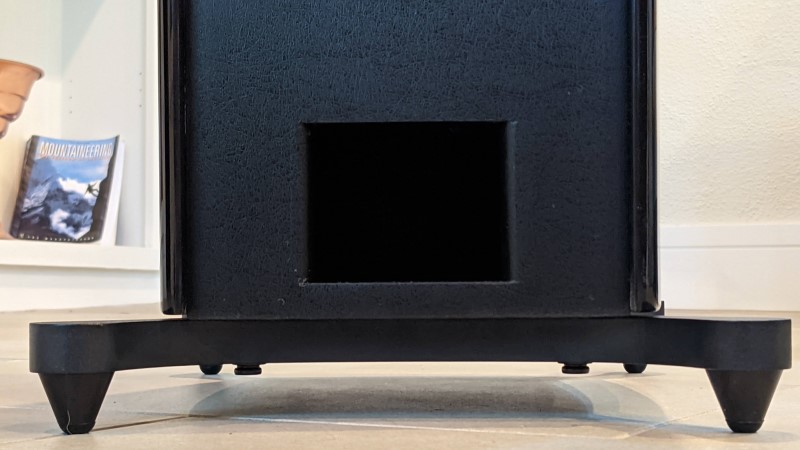
How Low Can the Atlantic Technology AT-3 Tower Speakers Go?
One of the design decisions behind the Atlantic Technology AT-3 tower speakers was creating a tower speaker that can play bass. So I tested it out. I listened to a lot of music with lots of bass and they were very well extended. Could I tell the difference when I engaged my subwoofers? Yes. But the differences were not major and most could be attributed to the room. But listening to music isn’t enough. Around here, if you really want to know how a speaker performs, you don’t listen to music, you listen to sweeps (you can download some here).
As we’ve said many times, the room makes a big difference in the bass you actually hear. I didn’t just play sweeps through the speakers, I played MANY sweeps AND I moved the speakers around the room. Moving the speakers a couple of feet forward gave me significantly different bass experiences. Suck-outs and boosts would change by up to 10 Hz.
In the end, I got usable bass down to the mid-to-low 30Hz range. After that, they completely fell off. For a speaker this size, that is a TON of bass. With that said, if I wanted EVEN bass, I needed to engage my subwoofers. Played by themselves, the speakers varied greatly in volume through the sweeps (I used a 100Hz and down sweep). Moving them, or me, around the room changed where those volume changes occurred, but didn’t eliminate them. After adding my two subwoofers into the mix and switching to Stereo mode, I suddenly had very even bass.
An Audiophile Design for Better or for Worse
The AT-3 speakers are clearly built with the audiophile in mind. The lack of drivers speaks to the minimalist aesthetic audiophiles typically crave. When we first looked at these speakers, we made a note that the difference in how the speakers were rated at the top end was strange. Well, it seems there was a reason for it.
During my listening tests, some of the highest sounds that I knew existing in the songs were lost. In particular, there is a song that has a couple of the highest piano notes. The piano tops out at just over 4 kHz. But these notes weren’t audible. I couldn’t tell if it was because the midrange and bass were somehow overshadowing them, or if the tweeter just couldn’t recreate them loudly enough. Regardless, the AT-3’s seem to have a pretty steep top-end roll-off.
Adequate but Unremarkable Imaging
The only other sonic issue I really had with the Atlantic Technology AT-3 tower speakers was the imaging. It wasn’t really bad, it just wasn’t spectacular. The center image was very easy to identify and side-to-side pans were fine. But any three-dimensionality of the soundtrack tended to collapse into one speaker or the other. I like to use a binaural recording that circles the room to test imaging. The AT-3s absolutely nailed the front and rear image. It would snap into place so concretely that it was unmistakable. But the circling part would just sound like one speaker was louder than the other. A grueling test for in-room speakers, for sure. But at this price point, I expected them to perform better.
Room for Improvement
Lastly comes the feet. I know that people love the looks of floor (carpet) spikes. Unfortunately, they don’t do anything good for your speakers. Coupling them securely to the floor sends any vibrations from the speaker into the structure of your home. We always prefer, and recommend, decoupling your speakers. That’s why, even on a carpeted surface, I use whatever rubber feet the manufacturer provides.
In the case of the Atlantic Technology AT-3’s, this took the form of rubber tips that could be exchanged for the spikes on the outriggers. I thought this was a great solution until I tried them. With only moving the speakers around to adjust toe-in, I broke off two of the four tips on one speaker. It appears that they are simply glued onto the ends of screws. At this price point, I expect much better. If you are going to use these tips, be very careful with them or risk damaging your floor.
Author’s Note: Atlantic Technology has contacted me and let me know that their engineers are working on a better solution for the rubber tips. When you are shopping, make sure you inquire about them and see what they’ve come up with.
The Verdict
We never recommend running speakers full range. The bass never sounds as good as it will with well-placed subwoofers. At $3300 a pair, the Atlantic Technology AT-3 tower speakers actually present a pretty good deal for delivering nearly 30Hz extension in-room. You really can’t ask for much more at this price point. You could spend many more dollars and not see any more bass. If you decided to buy from the website and not from a dealer, Atlantic Technology will give you $300 off if you mention this review! While there did seem to be some issues with the treble, it was only at the very top end and only noticeable because we knew what to listen for. If you really want full-range speakers, or really don’t want to add a subwoofer, the Atlantic Technology AT-3 tower speakers should be on your list to demo.
Original Preview Article
This week Atlantic Technology started shipping their ~$3k a pair tower speaker, the AT-3. This is a new speaker that makes improvements over the AT-1 they debuted back in 2011. This speaker sports a single woofer (instead of dual midranges) and a bunch of improvements. But what are the AT-3 tower speakers, how do they work, and why should you care? We walk you through this very unique (to most people) speaker design.
Getting that Audiophile “Feel”
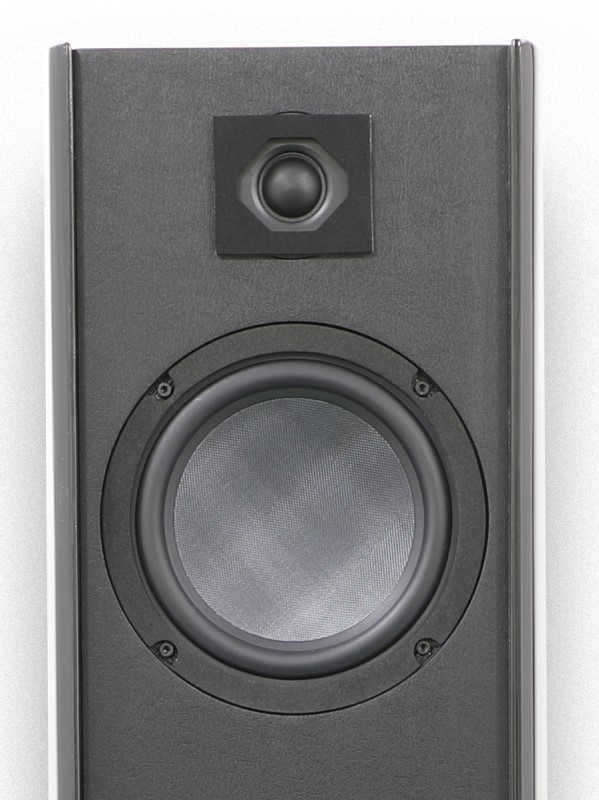
If you’ve ever visited a “true” audiophile trade show, you’ll notice a lot of very large speakers with only one or maybe two drivers. “Full range” is the goal of these speakers and the way to get there is a single driver within a big cabinet. These speakers are invariably exorbitantly priced and usually sport furniture-quality finishes. Beautiful but out of the reach of most people.
Atlantic Technology’s AT-3 is looking to capture that market at a much more affordable price point. The AT-3 tower speakers sport a single woofer and tweeter pair. The tweeter is a soft-dome silk design and the woofer has a 6.5″ fiberglass cone. Atlantic Technology spends a lot of their marketing material talking about how quick the drivers are but what they really mean is that they are light and that the woofer has a large extension.
The Case for Bass
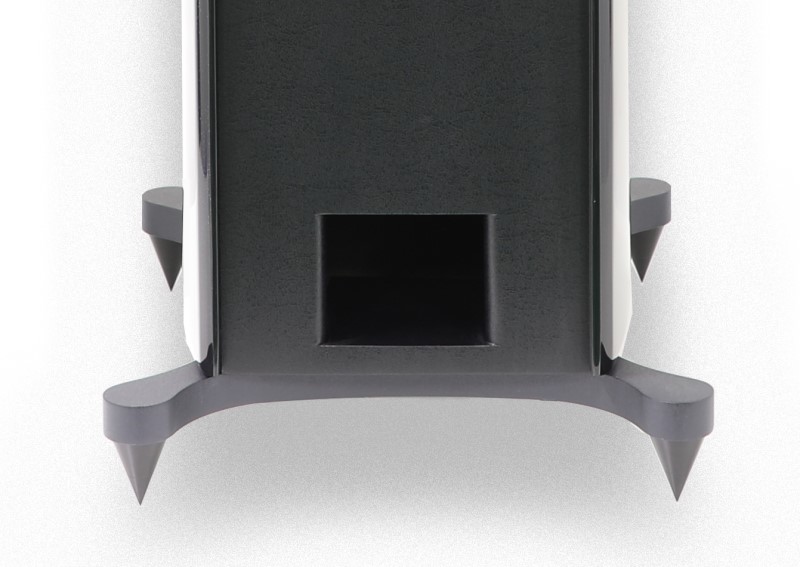
The real technology that the AT-3 tower speakers employ they call H-PAS (Hybrid Pressure Acceleration System) and is what most of us call a folded horn. If you look at the back of the speaker, you’ll notice that the connections are way up near the top. In fact, they’ve included “cable management” wire guides to keep your cables from being too visible. Why are the connections so high? Because the bottom 2/3rds of the cabinet is a folded horn.
While their design is proprietary so they don’t show pictures of it, we can make some inferences from the marketing speak:
“…the woofer’s back wave travels through an internal multi-compression chamber with an inverse horn structure for a continuous compression of the bass wave…”
AtlanticTechnology.com

This sounds like a folded horn that starts off wider and gets narrower toward the end (or maybe does that a couple of times, we don’t know). Regardless, a folded horn is a great way to get low bass out of a single driver. The horn is connected to the back of the woofer to take advantage of the back-wave. The sound is funneled through the horn and exits out the front-facing port. Atlantic Technology claims the AT-3’s will play down to 29Hz. That’s pretty impressive for a single 6.5″ woofer.
Other AT-3 Technology
Atlantic Technology’s AT-3’s have included a bunch of other upgrades and changes from the AT-1’s. Let’s look at them all.
Foam Surround for Tweeter
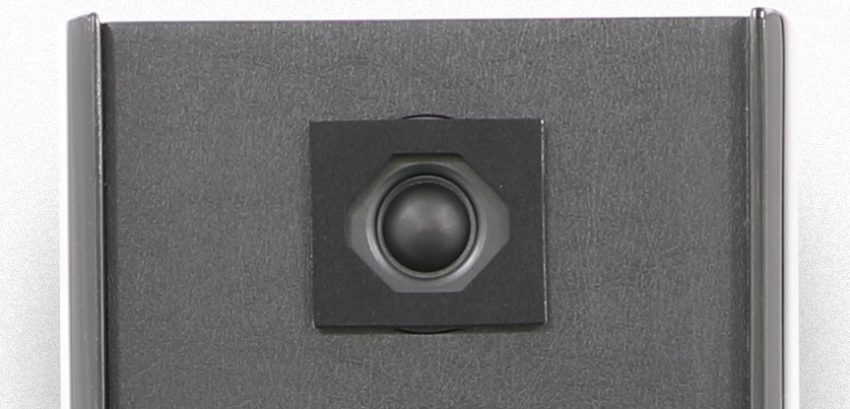
The AT-1’s had a single 1.1″ silk-dome tweeter nestled between two 5.25″ woofers. The AT-3’s have a single 1″ silk-dome tweeter and a single 6.5″ woofer. The tweeter has a bit of foam stuck to the cabinet around it. This is normally to reduce diffraction that can occur at the edge of the cabinet. Most speaker manufacturers “solve” the diffraction problem by rounding the edges of their cabinets. Historically, audiophiles that like to “tweak” their gear have lauded the effects of adding foam or wool around the tweeter. Atlantic Technology has done that for them. As the cabinet has a protruding frame along the left and right sides for the magnetic grille, the foam likely helps with diffraction as the sound waves hit that frame.
Low Tweeter Crossover Point
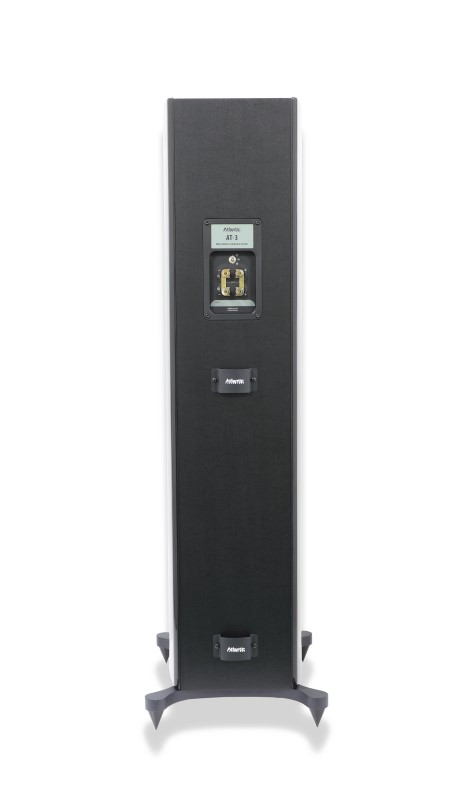
Both the AT-1 and AT-3 speakers have a very low crossover point for the tweeter at around 2kHz. This is done to prevent lobing between the woofer and the tweeter. Lobing is when sound from both drivers interact and interfere with each other destructively. Most commonly, this happens in the off-axis response. By lowering the crossover, the frequencies that both drivers are playing at the same time (around the crossover) are such that they don’t interact.
The downside of having a lower crossover is that you are asking the tweeter to play lower than it is generally designed to do. In most speakers that have such low crossovers, we see some sort of waveguide employed. Tweeters (especially your typical 1″ sized) don’t like to play very low as they start to distort and they get very directional. Waveguides help these problems. Atlantic Technology has clearly created a very robust tweeter for their AT-3 tower speakers. That should solve the distortion issues. We’re not really sure how they dealt with the directionality issue.
We did find it interesting that Atlantic Technology rated the AT-3 tower speakers differently at the 13kHz point. They are rated at +/-3dB from 29Hz to 13kHz, but +/-4dB from 13kHz to 20kHz. This suggests that something weird is going on at the highest frequencies. Designing a tweeter to play so low may have affected its stability at the highest frequencies. As most of us can’t hear sounds that high anyhow, it shouldn’t make much of a difference to most listeners.
Lowered Sensitivity
The AT-1’s claimed an 89dB sensitivity while the AT-3’s are rated at 85dB. What this means for you, the end-user, is that you’ll need more amplifier power to get the AT-3’s to play at the same volume. With a 6-ohm nominal impedance, you were probably going to pair these with an amplifier anyhow.
Tweeter Energy Control Switch

Like the AT-1, the AT-3 tower speakers have a Tweeter Energy Control switch which can boost or cut the tweeter’s response. They say this is for personal preference or to “compensate for different room acoustics.” If your room acoustics are harming the high frequencies, cutting them doesn’t solve the problem. It simply removes the frequencies. Some sources (we won’t link them here) claim that cutting the high-end energy of a speaker “controls” for room interactions. There is no empirical evidence that this is true. Room treatments control for room interactions, not switches on a speaker.
Other “Audiophile” Features
The AT-3 tower speakers have a bunch of additional features to spark interest in the audiophile crowd. We’ve already mentioned the extension. The audiophile wants a full range speaker. They don’t like subwoofers and think that all sound should come from their speakers. While 29Hz is pretty low at -3dB, it still leaves out the lowest frequencies. If you never plan to listen to organ music or movies, you might not care.

They also sport cast-iron carpet spikes, something we love the look of, but suggest NEVER using. They also come with rubber feet to protect hardwood floors. We suggest you use the rubber feet on all surfaces. You may also consider some sort of speaker platform to fully decouple these speakers if you plan on running them full range, not that we would recommend that either.
Are the Atlantic Technology AT-3 Tower Speakers for You?
The AT-3 towers tick all the audiophile boxes. Limited drivers, “full-range” extension, foam around the tweeters, tweeter switch to “tune” the high-end response, cast-iron carpet spikes…the list goes on. For an audiophile style speaker, the price tag at $3300 a pair, is extremely tempting. Speakers with these same design elements from an audiophile brand would cost much, much more. If you are looking for that type of speaker, but don’t want to outlay the cash they are asking, the AT-3’s should be a great option.
The fact is Atlantic Technology has made many speakers that we have liked. We have no reason to think that the AT-3 tower speakers will be any different. These are not speakers you’ll want to buy blind, however. The audiophile touches that Atlantic Technology has added has likely introduced a character to these speakers that may make them perform differently from any speaker you’ve heard before. Check them out. They may be the perfect speaker for you.

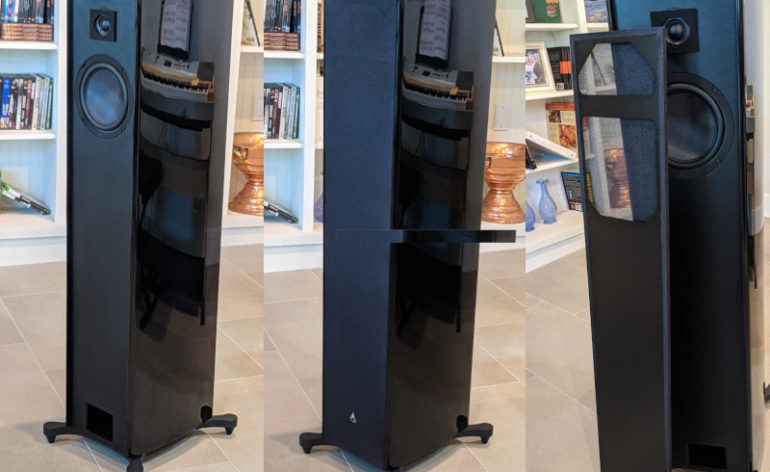

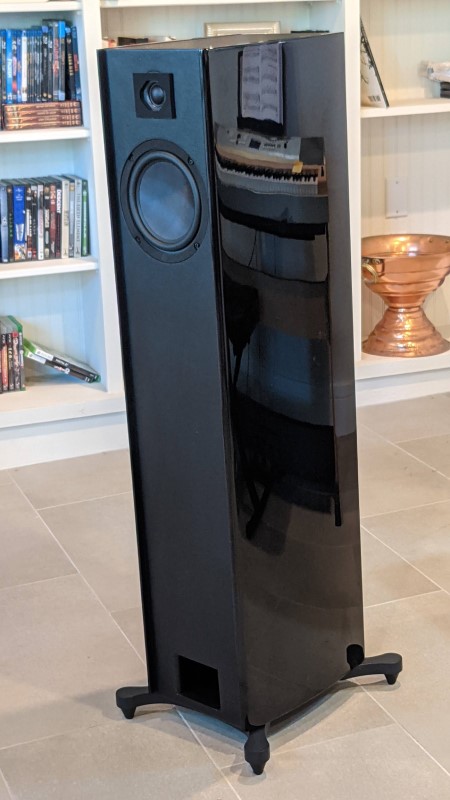
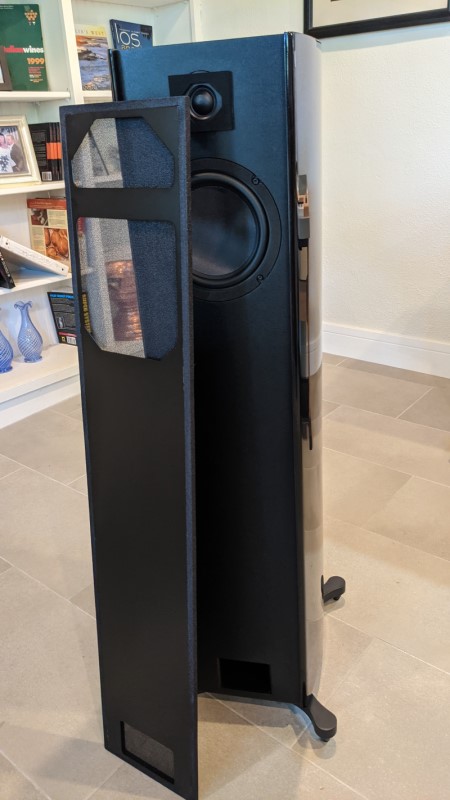
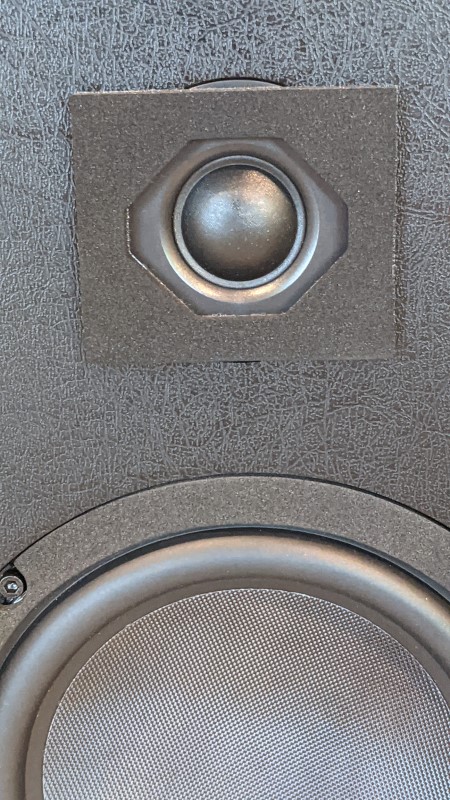
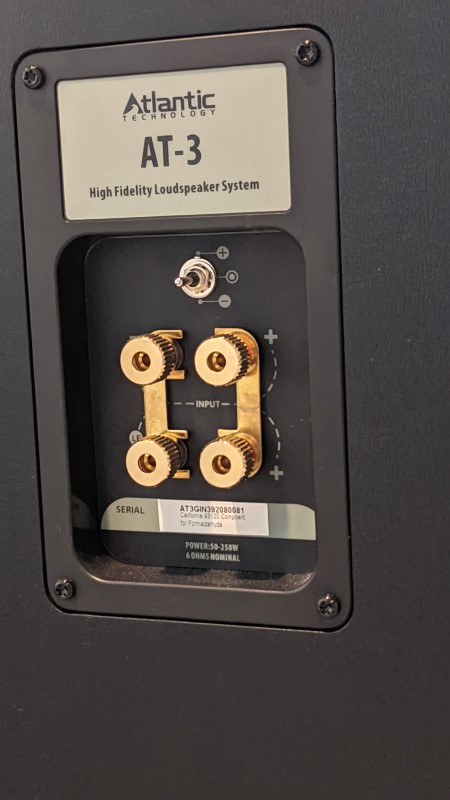
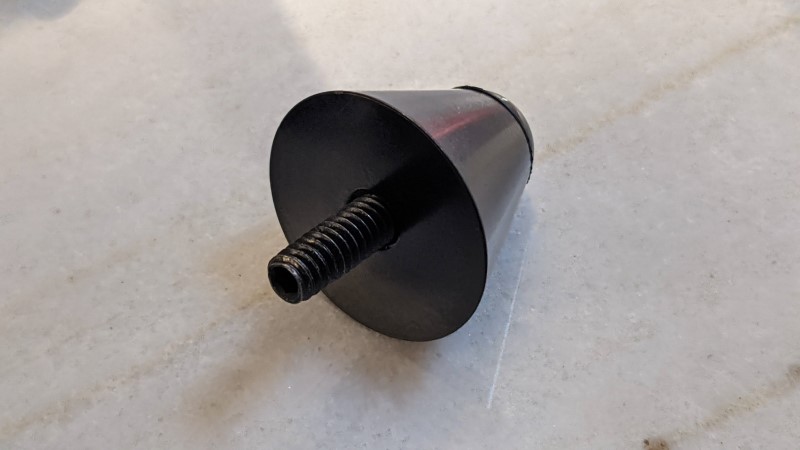
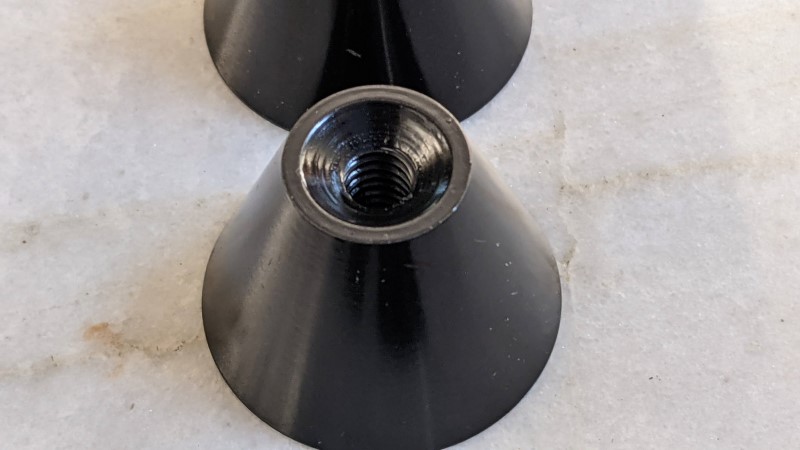
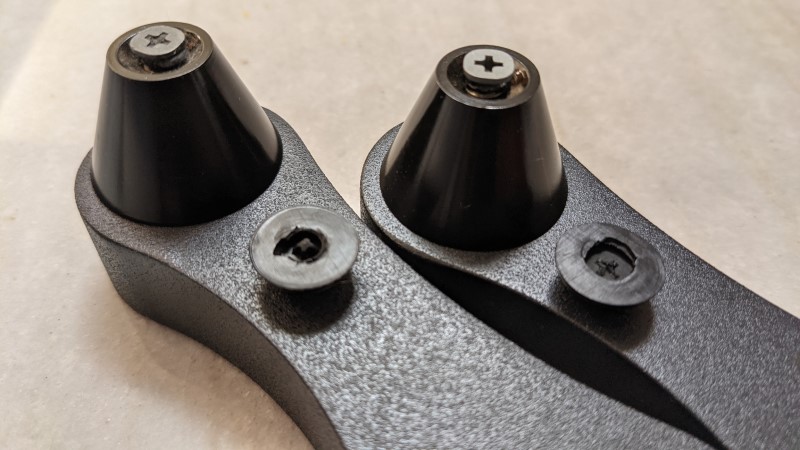
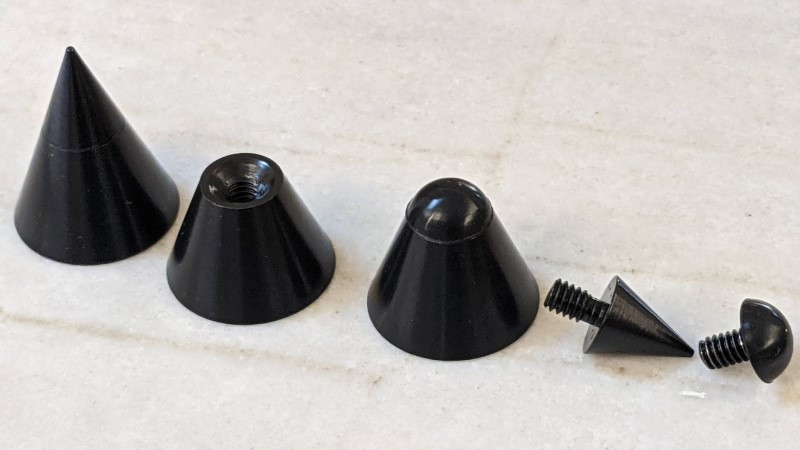

Tom,
Thank you for your comprehensive review of the Atlantic AT-3 speakers. You are correct in that few speakers of its size or price have such an extended low-end and dynamic response. As you mentioned these are characteristics usually found in far more expensive and larger systems.
The build quality you also mention is right on. Due in part to its internal bass system design, it’s significantly braced from the woofer down, with additional bracing also in the upper section. As you say it’s definitely a well-built product.
Your listening test referred to toeing in the speakers a bit toward the listener to get the fullest frequency response and the best balance the speaker can offer. This is very consistent with our own listening evaluations.
As for spatial attributes, imaging and front to back depth, it is different in every room and we believe these attributes are quite good in the AT-3. How good of course depends a lot on the room size and acoustic attributes. Working with placement can certainly help find a position or two for the speakers that allows for excellent side, imaging and front to back depth. We were glad to read you took the time in the evaluation to try different placements. We believe every room is the unsung hero in what folks ultimately hear at home.
We agree as you noted that the AT-3 is intended for audiophiles, a category that includes well built, great engineering, and great sound. While response curves weren’t published, the descriptions are pretty much in line with our own measurements. Our design reference is acoustic live music with a sonic design goal to create a well-balanced natural sound with a tonality that’s easy to listen to. Different design choices made therefore could include a tweeter set for a higher output producing a peak in the range described which is perfectly OK. With the AT-3, as in the design of many high-end speakers, we applied a subtle high-frequency warming to produce our desired sound. These are matters of personal preference found through auditioning speakers and thorough reviews.
We very much appreciate your thoughts regarding the feet, which we will definitely check into.
From all of us at Atlantic Technology we want to humbly thank you for a well-covered and well presented review of the AT-3 speaker and appreciate all your comments. We are very excited about this speaker, and as you say, clearly “have the audiophile in mind’, and anyone else that loves a full, wide frequency range that is smooth as well as dynamic with natural tonal sound. Such is the Atlantic Technology AT-3 loudspeaker.
Atlantic Technology’s products are available for purchase via our website https://shop.atlantictechnology.com/products/at3 as well as authorized dealers. Given that these are new speakers just rolling out to dealers and may not immediately be available in every area, Atlantic Technology is extending a special bonus to AV Gadget readers. Between now and the end of 2021, when AV Gadget readers purchase the AT-3’s via our website we will discount the speakers from our normal $3,299 per pair price to $3,000 per pair which is the same price you’d pay purchased from an authorized Atlantic Technology dealer. Just mention AV Gadget when ordering and your price will be $3,000 per pair (plus any applicable shipping and taxes).
Best Regards,
Paul Fredrickson
Muto Communications for
Atlantic Technology